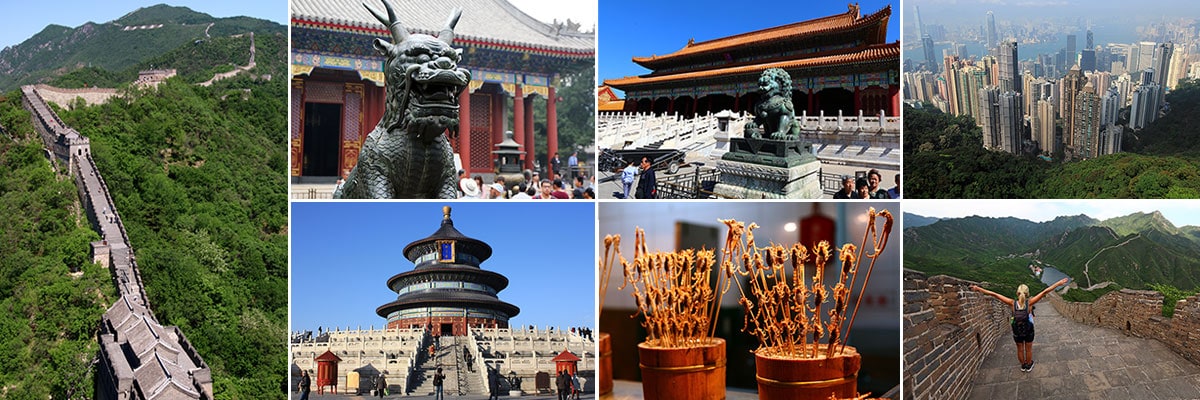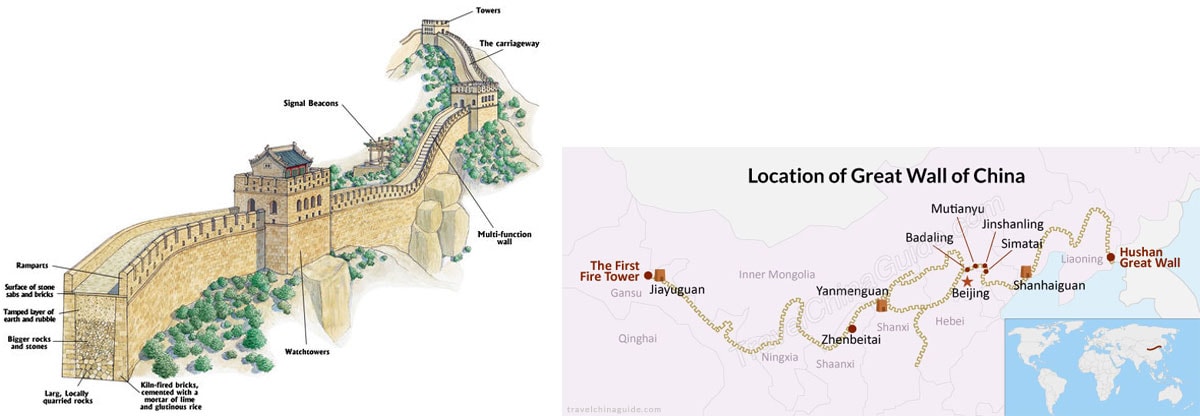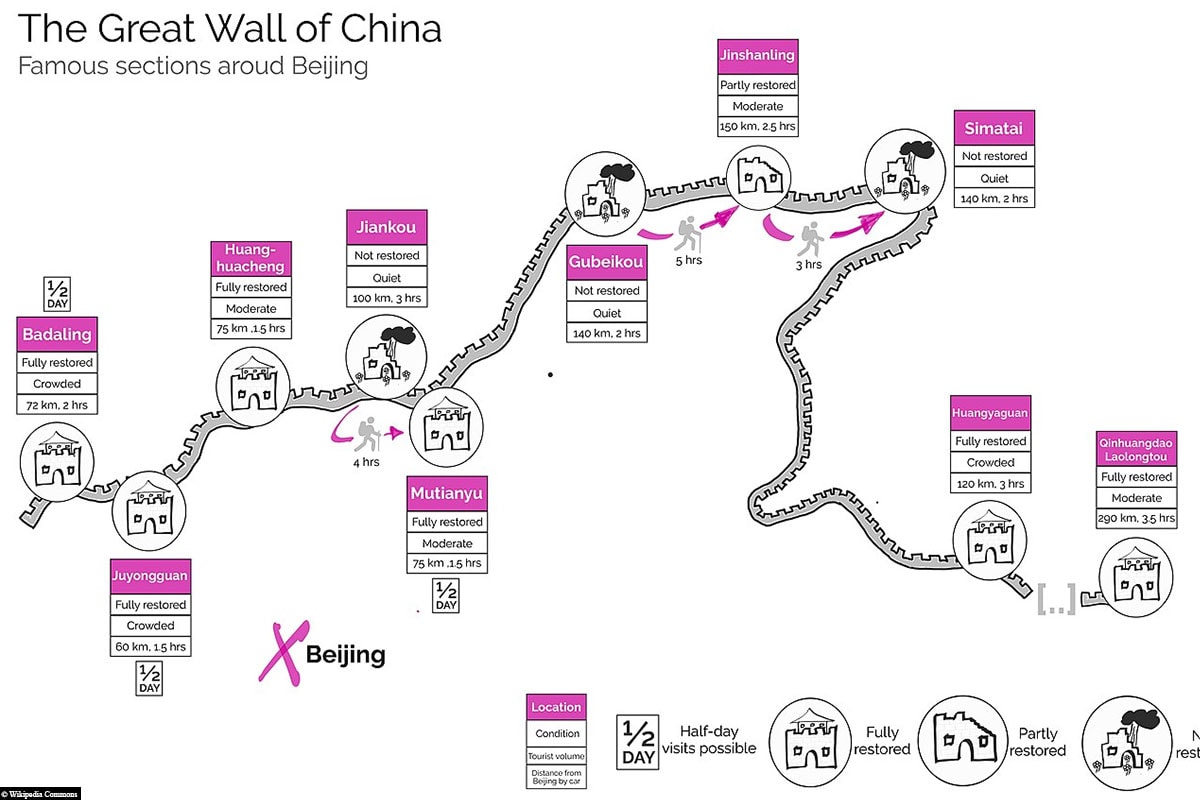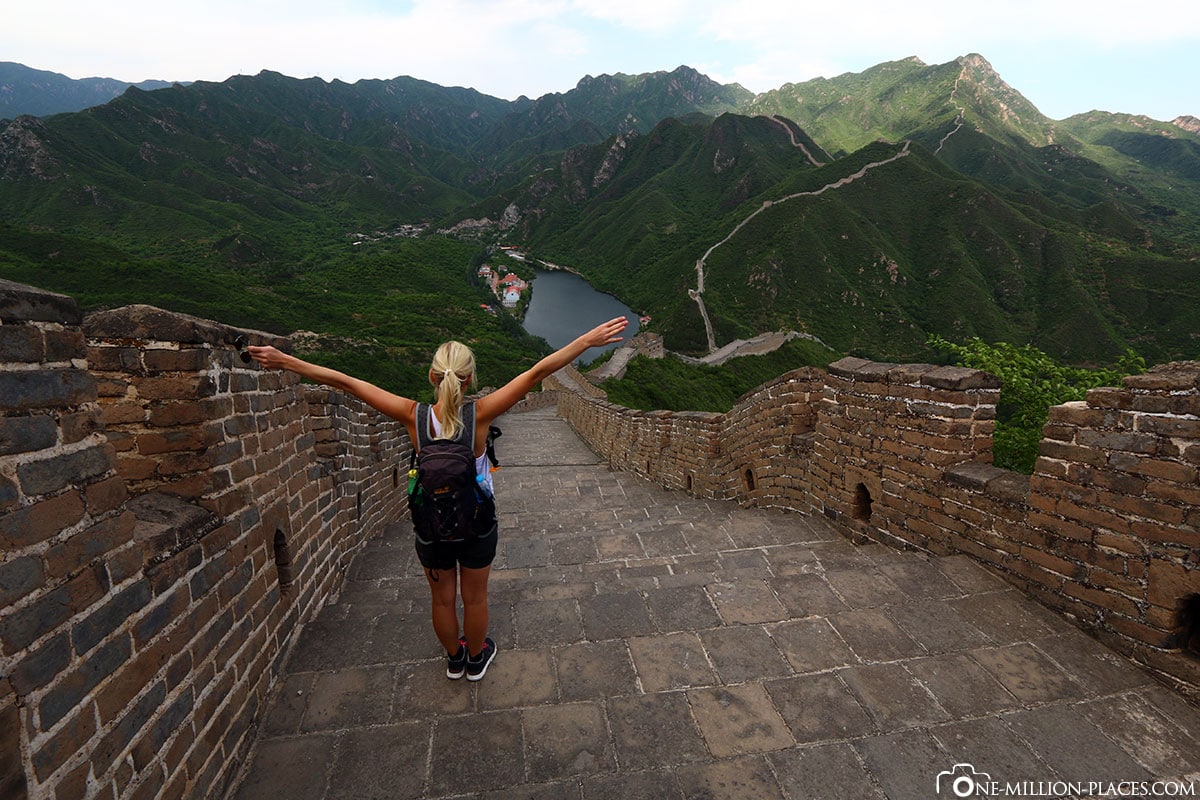After visiting the Chinese Wall near Mutianyu this morning, we had to visit another part of the wall in Huanghuacheng.
Table of contents
Things to know about the Great Wall of China
The Great Wall of China (also known as the Great Wall) is a historic border fortification and, according to the latest surveys, extends over a length of 21,196 kilometers through China and comprises 43,721 individual objects and locations. The wall consists of a system of several sections of different ages and constructions, some of which are not connected to each other, whose main wall is 2,400 km long. In total, the wall covers 15 provinces, autonomous areas and cities. The Great Wall is now constantly being restored by state funding, the sections of the sections are less than 10 intact,while the rest are in poor condition. In some cases, only the massive foundations are still there. Today, four sections of tourists can officially be visited. The most famous restored section of the wall stretches near Badaling, 70 km northwest of Beijing. Other touristic sections are located at Mutianyu, Huanghuacheng, Simatai and Jinshanling. [Source: Wikipedia]
A total of 3 million workers were involved in the construction of the wall between the 5th century. and 16th century Involved. It is hard to imagine how this building, which stretches along the ridges of the hills through green landscapes, was built at that time. The Great Wall of China is therefore rightly one of the 7 new wonders of the world on earth and is also a UNESCO World Heritage Site.
The road to the wall at Huanghuacheng
The difference between the sections of the walls of Mutianyu and Huanghuacheng is that in Huanghuacheng you can see mainly older, unrestored parts of the wall. From the parking lot in the small village of Zhuangdaokou Village we had to hike steeply up hill for 30 minutes over small paths to the wall section before we could enter the wall. Since this region of the Wall is absolutely not accessible for tourism, unlike Mutianyu, there are no stalls or cable cars. And apart from us and our guide, no one else was there – absolutely fantastic 🙂
The following route is planned for the wall in Huanghuacheng:
01. Ascent to the wall (marked in red)
02. A non-restored part of the wall (marked in blue)
03. A restored part of the wall (marked in yellow)
The unrestored part of the Great Wall of China
So first we walked to the left to an unrestored part of the Great Wall. The first few meters are still relatively well preserved. But already after a few meters you can see in what bad condition the wall is already at this point. Sometimes you don’t see the wall anymore because of the vegetation 😉
For a long time, the government has not taken care of the care and preservation of the Great Wall of China. In some rural areas, Chinese residents have even torn down parts of the wall to use the material for their own construction. Only since 2006 the wall is completely protected and must not be damaged any more,but must be preserved in its current condition. A survey of the wall between 2007 and 2009 showed that only 513 km of the 20,000 km long wall is in good condition. The rest is destroyed, smeared with graphittis, worn off or overgrown by wild plants. And this can be seen very well at Huanghuacheng. Here you will find a part of the wall, which nature reclaims bit by bit.
From this point on, we should not go any further, because the wall is dangerous to collapse in many places here. This can be seen in the fact that the watchtowers sometimes have huge cracks. That was impressive to see the wall in this bad condition.
So we went back again to continue the wall to the north. You really have to be careful here, because this Teiil is really not secured and sometimes also very steep. If the wall in Mutianyu is usually several meters wide, it is here by removals partly only 1-2 meters wide.
The Function of the Great Wall of China
The Great Wall of China was originally built as a purely defensive facility. The watchtowers were used for this purpose, of which there are said to have been up to 25,000 stück in the heyday of the building. They were signal towers in the first place, but at the same time they were also weapons depots. As soon as an enemy was spotted, a guard on the tower lit a fire, informing the surrounding towers of the approaching threat. In this way, a well-thought-out, effective protection systemwas created, which certainly played a major role in China’s path to becoming a world power. [Quelle chinesischemauer.net]
The restored part of the wall in Huanghuacheng
If you walk the wall in the other direction, you come to a longer partially restored piece. Restored does not mean that the wall looks like in Mutianyu or Badaling. But at least the decline was stopped. And again, there was no human soul to be seen. The ascent was very steep, strenuous and sweaty.
No matter how strenuous the ascent in the temperatures is – the view from the top point has compensated for everything. The sheer madness! To be so completely alone in such a great place on the wall is an absolutely grandiose feeling. At this point you can see perfectly how the wall winds over the mountain slopes for miles.
From here we then cautiously started the descent towards the valley.
Shortly before reaching the valley, a small private path descends from the wall. Our guide had previously clarified that we can use the path. In fact, access to the wall (probably for security reasons) is not allowed at this point.
Our video of the Great Wall of China at Huanghuacheng
Here is a little video of our walk on the Great Wall of China near Huanghuacheng.
In the valley we had together with our guide in a small local inn a well-deserved, typical local lunch, which was very tasty. After two hours by car we arrived back in Beijing then our guide at Silk Market – a big fake market – let us out, because we wanted to stroll a bit here. Around 9 p.m. we were back in the hotel after a long and exhausting day. What a great experience! 🙂
All travelogues from China
We find China incredibly exciting as a travel destination. The culture, the history, modern cities, UNESCO world heritage sites - the country is really huge and there is so much to see. So far we have only seen a small part of China, but we are certainly planning a longer trip there in the future. » Hong Kong: Explore tourist attractions & things to do
» Hong Kong: Explore tourist attractions & things to do» Hong Kong: Peak Tram & the viewpoint from Victoria Peak
» Hong Kong: Ten Thousand Buddhas Monastery & the Big Buddha
» China: Beijing – Our problem with the 72-hour transit visa
» China: Beijing – Tian’anmen Square & The Temple of Heaven
» China: Beijing – A daytrip to the New Summer Palace
» China: Beijing – Local Street Food at Wangfujing Snack Street
» China: Great Wall of China – The Wall Section at Mutianyu
» China: Great Wall of China – The Wall Section at Huanghuacheng
» China: Beijing – The Forbidden City & Jingshan Park





